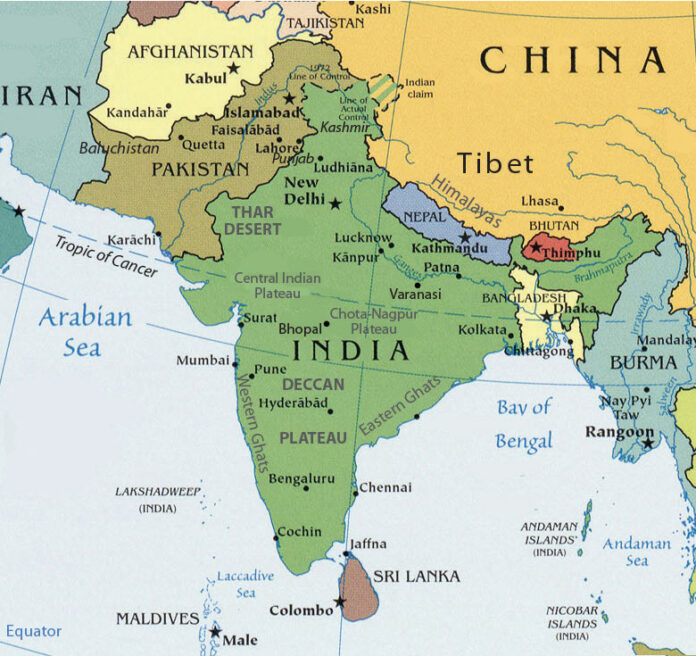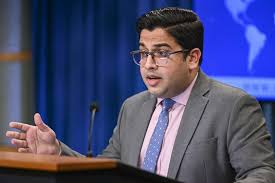The recent popular term, ‘South Asia’ in world politics, has traditionally been defined in several perspectives like geography, history, ethnicity, politics, culture and also known as the southern subregion of Asia, situated on the Indian plate which includes seven countries of the region-India, Pakistan, Bangladesh, Sri Lanka, Nepal, Maldives, Bhutan but now in its periphery we frequently include Afghanistan, which is classified as a Central Asian country. In the context, partition of the Indian subcontinent in 1947, as a result of which Pakistan emerged and again in 1971 when Bangladesh took birth as an independent and sovereign country of the globe, for many including these two the term, ‘Indian’ subcontinent became offensive and suspicious. The new developments and feelings gave in increasing hand to the term South Asia, while Indian subcontinent began lessening in in use at regional and global levels. In addition, because of the socio-cultural commonalities of the region it has also been called ‘Asian subcontinent’, ‘South Asian subcontinent’ India as well as Greater India in classical or pre-modern sense. Especially, events which took place in early and mid-seventies, like nuclear explosion by India in May 1974 and integration of Tibet in 1975, made India’s neighbours including the small powers of the region apprehensive about country’s motives and designs. The atmosphere of fear and suspicion gave birth to the famous regional organisation- the South Asian Association for Regional Co-operation (SAARC) in December of which India was also a founder member and other nations of South Asia played a decisive role in its making.
Population Profile
Over the years and decades since partition of the Indian subcontinent in 1947, several regional as well as global changes of immense significance took place which shaped the contemporary/future course of action and behavioural approach of powerful nations of the area and the world. As the region South Asia occupies about 5.2 million kilometre of land which is 11.71% of world’s surface portion, while in sphere of population it is the most populous and most dense populated regions of the globe, having 24% of world’s population and 39.49% of Asia’s population. According to an estimate it accounts for the largest populations of Hindus, Muslims, Sikhs, Jains, and Zoroastrians, accounting for 98.47 of Hindus, 90.5% of Sikhs, and 31% of Muslims, 35 million Christians and 25 million Buddhists. Thus, from religious points of view, South Asia had/has the largest population of Hindus, Buddhists, Jains, Sikhs, and Christians scattered in India, Nepal, Sri Lanka, and Bhutan, while the Muslims of the region are concentrated in Afghanistan (99%), Bangladesh (90%), Pakistan (96%), and Maldives (100%). Although, all religions which are deeply rooted in South Asia like Hinduism, Jainism, Buddhism, and Sikhism have regional origin except Islam and Christianity, simultaneously, they all, in course of time, spread to East Asia and Southeast Asia. In the context, while, Christianity and Islam were taken to the coastal region by the merchants who settled there with local populations, the latter conquest of Sindh, Balochistan, and parts of Punjab by the Arab Caliphates with which came an influx of Muslims from Persia and Central Asia. It not only resulted in the spread of Shia and Sunni Islam in parts of the region, but because of the influence of Islamic Sultanates including the Mughal Empire, Islam spread forcefully in the South Asia and made it a home of one-third of the world’s Muslims.
Over the years and decades since partition of the Indian subcontinent in 1947, several regional as well as global changes of immense significance took place which shaped the contemporary/future course of action and behavioural approach of powerful nations of the area and the world.
Economic Status
This apart, the first decade of twenty-first century registered a remarkable growth and progress in respect of economy where new found development of India was taken as special while on the other, the increasing number of extremist/terrorist incidents in Pakistan and Afghanistan presented a different picture of the region. In the context, while Indian economic development attracted many countries of the region including the People’s Republic of China, the terror profile of South Asia attracted many global powers as they were facing the same problem in their homeland. Over the years, the economic leap of India which has made it world’s fifth largest economy in normal terms but 3rd by purchasing power with an 80% contribution to the economy of South Asia. It is the member of G-20, a global organisation of world economic power and BRICS and is considered as the fastest growing economy obtaining an average growth of 7%, although, in recent few years, Bangladesh has surpassed India in terms of growth rate and registered a GDP as well as per capita income above both India and Pakistan. According to various surveys and reports Bangladesh is among the eleven emerging economies of the world and fastest-growing middle-income nations. It has/had maintained an increasing annual growth rate which crossed 7% in the financial year 2015-16 in comparison to continued growth rate of 6 % in recent decade and expected to grow high in coming years/decades. Next to Bangladesh in the region is Pakistan which holds 5th position in terms of GDP and per capita income in the region South Asia. By the time the South Asian share in global economy received a leap unexpectedly and made it a world hot-spot of regional as well as global powers simultaneously.
Educational changes
The other aspects which attracted the world’s attention towards South Asia are education and mal-nutritional status of the region and mixed politics prevailed in the region particularly since partition of the Indian sub-continent in 1947. The education system of South Asia as available in countries of the region are challenging as well as complicating because there are number of pitfalls in the structural arrangements which largely lack quality, proper skill development programmes as well as mass drop-outs in almost all nations. Several observations and studies conducted by different agencies- governmental and non-governmental support the view that only 48% children of Indian schools and 46% of Pakistani schools could read a class two text when they reach in class five. Their class rooms are also teacher-based where they hardly take care of learners and students in general receive a unjustifiable punishments on minor faults. For schools-public and private both centralised and decentralised systems are in practice and partly they all but India and Pakistan have gradually moved towards establishing more private educational institutions to get more skilled man-power and required skill-set in this era of globalisation. Along with them other nations of South Asia, including Bangladesh, Sri Lanka, Maldives, Bhutan, Nepal are struggling hard to accommodate with new challenges and social requirements as well.























